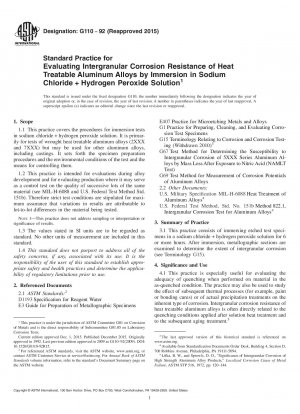ASTM G110-92(2015)
Standard Practice for Evaluating Intergranular Corrosion Resistance of Heat Treatable Aluminum Alloys by Immersion in Sodium Chloride&x2009;+&x2009;Hydrogen Peroxide Solution
- Standard No.
- ASTM G110-92(2015)
- Release Date
- 1992
- Published By
- American Society for Testing and Materials (ASTM)
- Status
- Replace By
- ASTM G110-92(2022)e1
- Latest
- ASTM G110-92(2022)e2
- Scope
4.1 This practice is especially useful for evaluating the adequacy of quenching when performed on material in the as-quenched condition. The practice may also be used to study the effect of subsequent thermal processes (for example, paint or bonding cures) or of actual precipitation treatments on the inherent type of corrosion. Intergranular corrosion resistance of heat treatable aluminum alloys is often directly related to the quenching conditions applied after solution heat treatment and to the subsequent aging treatment.5
4.2 This practice is not well suited for non-heat treatable work hardening aluminum alloys, such as the 1XXX, 3XXX, and 5XXX series (see Test Method G67).
4.3 This practice does not deal with the interpretation of resulting intergranular corrosion. The significance of the extent and depth of any intergranular corrosion resulting from this test is to be agreed upon between producer and user.
1.1 This practice covers the procedures for immersion tests in sodium chloride8201;+8201;hydrogen peroxide solution. It is primarily for tests of wrought heat treatable aluminum alloys (2XXX and 7XXX) but may be used for other aluminum alloys, including castings. It sets forth the specimen preparation procedures and the environmental conditions of the test and the means for controlling them.
1.2 This practice is intended for evaluations during alloy development and for evaluating production where it may serve as a control test on the quality of successive lots of the same material (see MIL-H-6088 and U.S. Federal Test Method Std. 151b). Therefore strict test conditions are stipulated for maximum assurance that variations in results are attributable to lot-to-lot differences in the material being tested.
Note 1: This practice does not address sampling or interpretation or significance of results.
1.3 The values stated in SI units are to be regarded as standard. No other units of measurement are included in this standard.
1.4 This standard does not purport to address all of the safety concerns, if any, associated with its use. It is the responsibility of the user of this standard to establish appropriate safety and health practices and determine the applicability of regulatory limitations prior to use.
ASTM G110-92(2015) Referenced Document
- ASTM D1193 Standard Specification for Reagent Water*, 1999-04-20 Update
- ASTM E3 Standard Practice for Preparation of Metallographic Specimens*, 1995-04-20 Update
- ASTM E407 Standard Practice for Microetching Metals and Alloys*, 1999-04-20 Update
- ASTM G1 Standard Practice for Preparing, Cleaning, and Evaluating Corrosion Test Specimens*, 1999-01-01 Update
- ASTM G15 Standard Terminology Relating to Corrosion and Corrosion Testing*, 1999-04-20 Update
- ASTM G67 Standard Test Method for Determining the Susceptibility to Intergranular Corrosion of 5XXX Series Aluminum Alloys by Mass Loss After Exposure to Nitric Acid (NAMLT Test)*, 1999-04-20 Update
- ASTM G69 Standard Test Method for Measurement of Corrosion Potentials of Aluminum Alloys*, 1997-04-20 Update
ASTM G110-92(2015) history
- 2022 ASTM G110-92(2022)e2 Standard Practice for Evaluating Intergranular Corrosion Resistance of Heat Treatable Aluminum Alloys by Immersion in Sodium Chloride + Hydrogen Peroxide Solution
- 2015 ASTM G110-92(2022)e1 Standard Practice for Evaluating Intergranular Corrosion Resistance of Heat Treatable Aluminum Alloys by Immersion in Sodium Chloride + Hydrogen Peroxide Solution
- 1992 ASTM G110-92(2015) Standard Practice for Evaluating Intergranular Corrosion Resistance of Heat Treatable Aluminum Alloys by Immersion in Sodium Chloride&x2009;+&x2009;Hydrogen Peroxide Solution
- 1992 ASTM G110-92(2009) Standard Practice for Evaluating Intergranular Corrosion Resistance of Heat Treatable Aluminum Alloys by Immersion in Sodium Chloride + Hydrogen Peroxide Solution
- 1992 ASTM G110-92(2003)e1 Standard Practice for Evaluating Intergranular Corrosion Resistance of Heat Treatable Aluminum Alloys by Immersion in Sodium Chloride + Hydrogen Peroxide Solution
- 1992 ASTM G110-92(1997) Standard Practice for Evaluating Intergranular Corrosion Resistance of Heat Treatable Aluminum Alloys by Immersion in Sodium Chloride + Hydrogen Peroxide Solution
